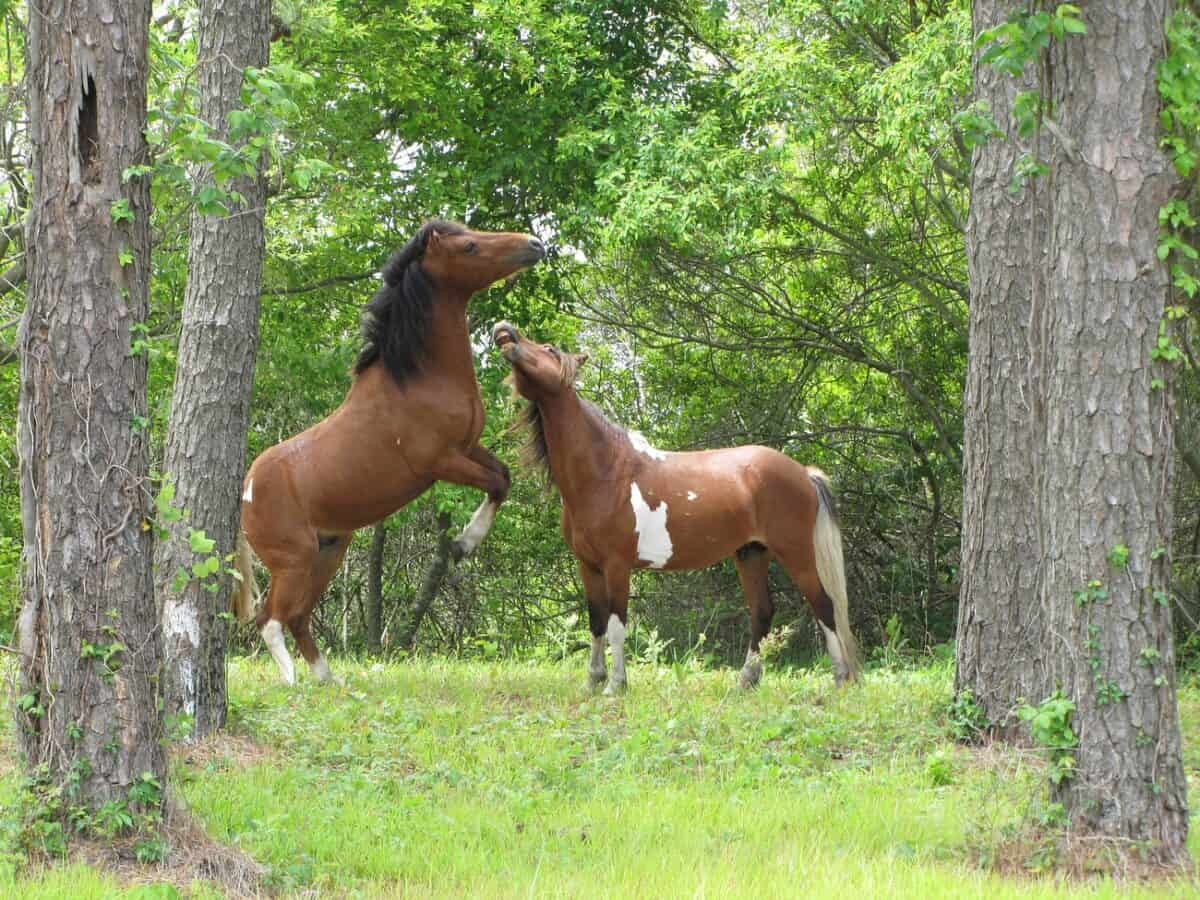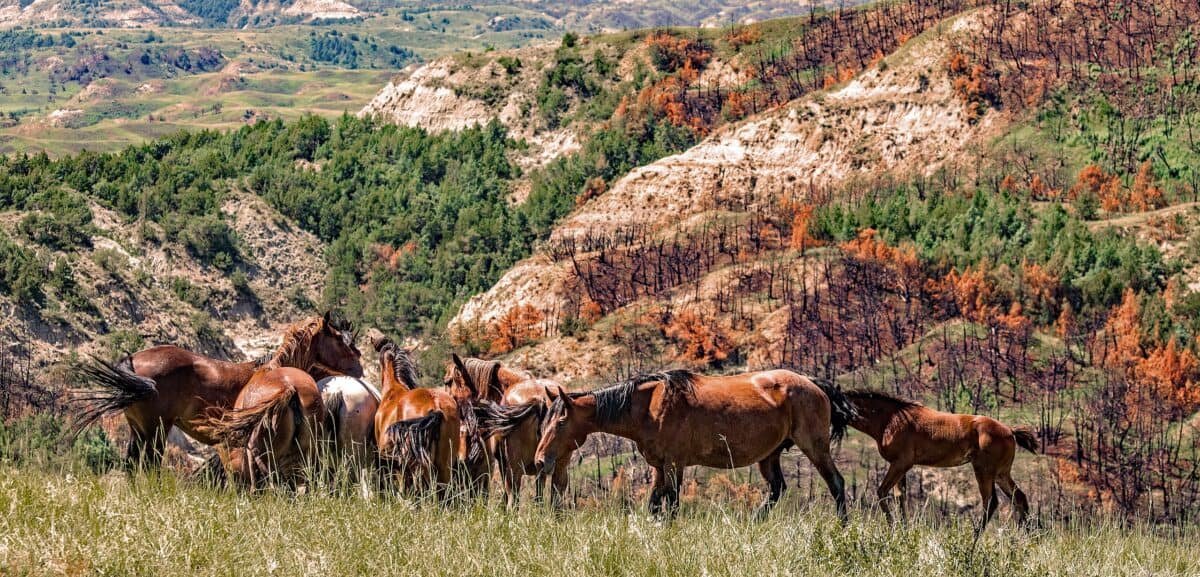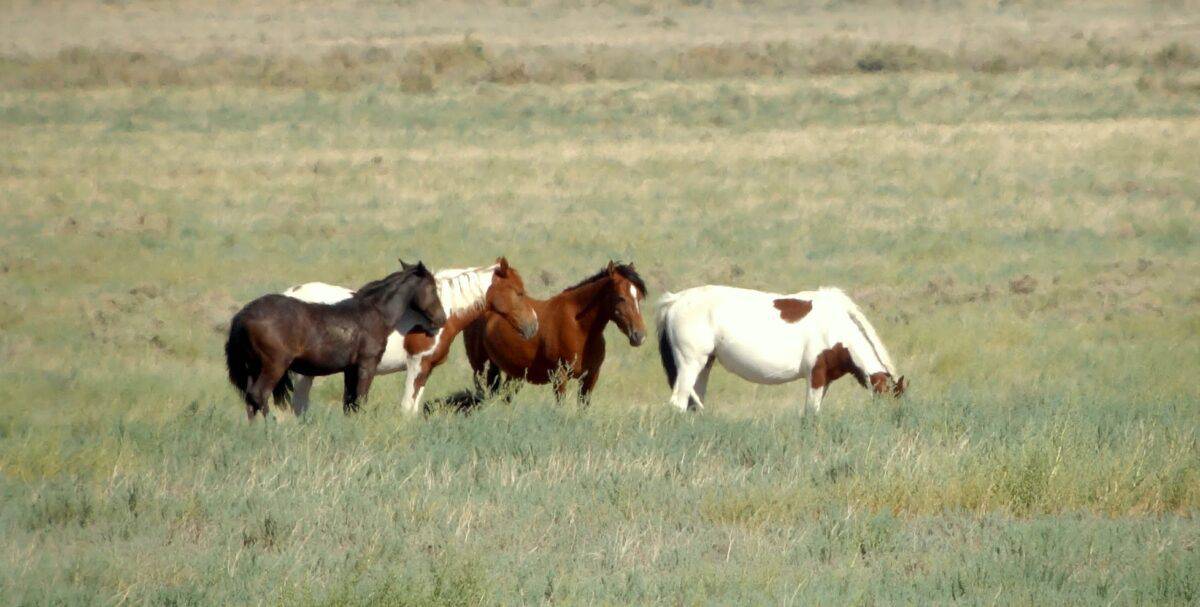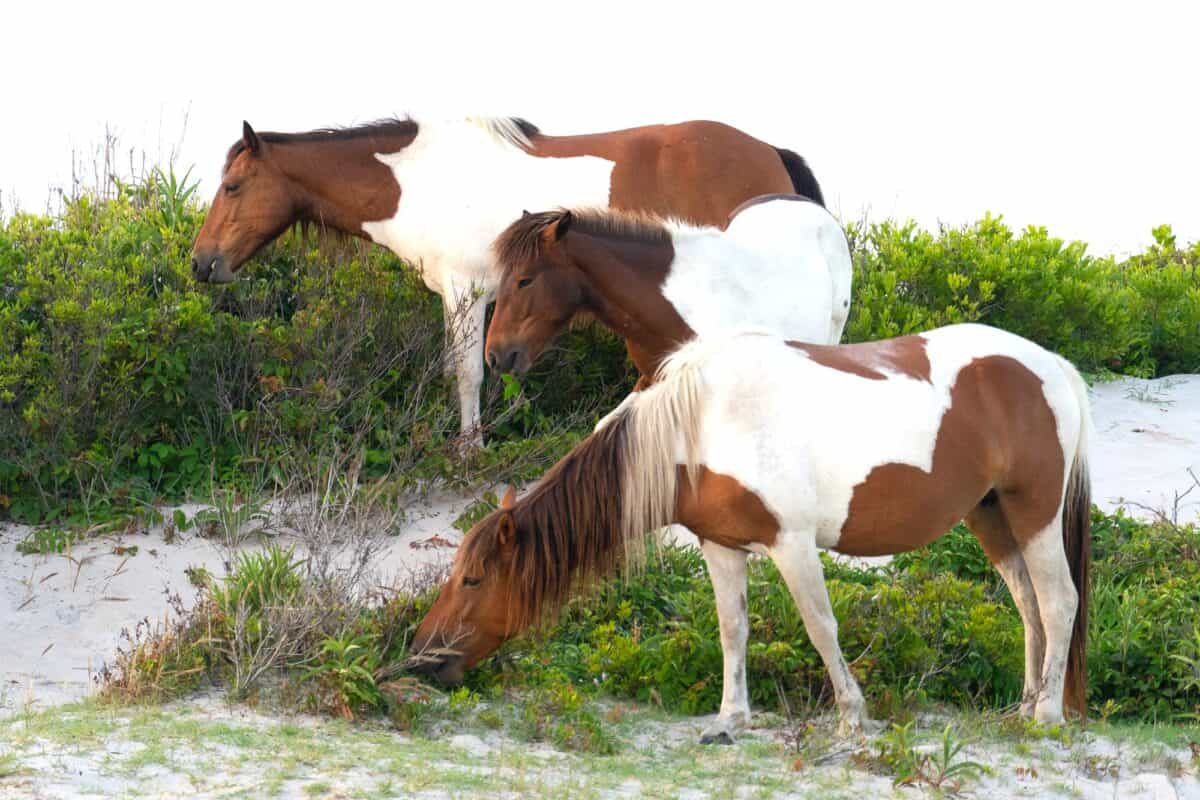Off the Atlantic coast of Maryland and Virginia lies a hidden gem that seems frozen in time – Assateague Island. This 37-mile-long barrier island is home to pristine beaches, diverse wildlife, and perhaps most famously, a population of wild horses that outnumbers its human residents. These magnificent creatures roam freely across salt marshes, coastal forests, and sandy beaches, creating a scene that feels more like a fantasy than reality. The wild horses of Assateague have captured the imagination of visitors for generations, offering a rare glimpse into a world where these majestic animals live largely untouched by human interference. Their story is one of resilience, adaptation, and the enduring bond between nature and legend in one of America’s most unique ecosystems.
The Geographic Wonder of Assateague Island

Assateague Island is a remarkable 37-mile barrier island that stretches along the coastlines of Maryland and Virginia. The northern two-thirds of the island falls within Maryland’s borders, while the southern third belongs to Virginia. This narrow strip of land, never more than a mile wide at any point, is separated from the mainland by Sinepuxent Bay, Chincoteague Bay, and Assateague Channel. The island’s ever-changing landscape is shaped by powerful coastal processes, including ocean storms, wind, and waves that continuously redefine its shores. Protected as Assateague Island National Seashore since 1965, this dynamic ecosystem features diverse habitats ranging from sandy beaches and dunes to maritime forests and salt marshes, creating an ecological sanctuary for countless plant and animal species, including its famous equine residents.
The Origin Story: How Did Horses Arrive on Assateague?

The origin of Assateague’s wild horses remains shrouded in romantic legend and historical speculation. The most popular tale suggests they descended from survivors of a Spanish galleon shipwreck off the coast in the 17th century. According to this narrative, the horses swam ashore from a sinking vessel bound for the Spanish colonies and established themselves on the island. While this makes for a compelling story, many historians and biologists believe a more likely explanation is that the horses are descendants of animals belonging to early colonial settlers. Historical records indicate that mainland farmers may have placed their livestock on the island in the late 1600s to avoid fencing laws and taxation on domesticated animals. Over generations, these once-domesticated horses adapted to the harsh island environment, becoming the resilient wild population we see today. DNA testing has revealed that the horses have genetic markers consistent with domestic breeds from colonial America, lending credence to the settler theory while not completely ruling out the possibility of shipwreck survivors contributing to the population.
Population Numbers: Horses vs. Humans

The disparity between equine and human residents on Assateague Island creates a truly unique demographic profile. The island sustains approximately 300 wild horses across both its Maryland and Virginia portions, while having virtually no permanent human residents. The Maryland section is home to around 80-100 horses managed by the National Park Service, while the Virginia side (known as Chincoteague) hosts about 150 horses managed by the Chincoteague Volunteer Fire Company. In stark contrast, the island has no permanent human settlement, with only seasonal Park Service staff, researchers, and day visitors comprising the human presence. Unlike many inhabited islands along the Atlantic coast, Assateague has been preserved without residential development, hotels, or commercial centers. This conservation approach has maintained the island’s natural character while allowing the horse population to thrive relatively undisturbed. During peak summer months, daily visitors can number in the thousands, but these people return to mainland accommodations by evening, leaving the island primarily to its four-legged inhabitants when the sun sets.
Not True Wild Horses: The Feral Distinction

Despite their common designation as “wild horses,” the equines of Assateague are technically feral horses – domesticated animals whose ancestors escaped or were released from captivity. True wild horses, such as the endangered Przewalski’s horse of Central Asia, have never been domesticated and represent distinct genetic populations that evolved in the wild. Assateague’s horses, by contrast, descended from domestic stock and subsequently adapted to life without human care over many generations. This distinction is more than semantic – it means that Assateague’s horses retain certain physical and behavioral traits from their domestic origins while having developed adaptations specific to island survival. Their smaller size compared to many domesticated horses (typically standing 12-14 hands high) represents one such adaptation, allowing them to navigate dense vegetation and reducing their nutritional requirements in an environment with limited resources. Though feral, these horses have established a sustainable population balance in their island habitat, with natural selection favoring individuals best suited to the coastal conditions. Their successful adaptation demonstrates the remarkable plasticity of horses as a species and their ability to return to a self-sufficient existence when given the opportunity.
Life in Two Distinct Herds: Maryland vs. Virginia

The wild horse population of Assateague is divided into two distinct herds separated by a fence at the Maryland-Virginia state line. This division, established in 1965, has led to different management approaches and somewhat different lifestyles for each group. The Maryland horses, managed by the National Park Service, live as a truly wild herd with minimal human intervention. They roam freely throughout their territory, forming natural band structures led by dominant stallions. The Virginia horses, known as the Chincoteague ponies, are owned and managed by the Chincoteague Volunteer Fire Company and live on the Chincoteague National Wildlife Refuge portion of the island. These horses experience more human oversight, including veterinary care and the famous annual Pony Swim and auction (made famous by Marguerite Henry’s book “Misty of Chincoteague”). Interestingly, the separation has also led to subtle physical differences between the herds over generations. The Maryland horses tend to have a more rugged appearance reflective of their wilder lifestyle, while the Virginia ponies sometimes show more diverse coloration patterns. Despite these differences, both herds share the core adaptive traits necessary for survival in the challenging barrier island environment.
Surviving on Salt Marsh Grasses: Remarkable Adaptations

Perhaps the most extraordinary adaptation of Assateague’s wild horses is their ability to thrive on a diet that would sicken or kill most domestic horses. These resilient animals have evolved specialized physiological systems to survive on the salt marsh vegetation that dominates their habitat. While domestic horses require fresh water, Assateague’s feral horses can drink brackish or salt water when necessary, thanks to adaptations in their kidneys that allow them to process higher salt concentrations. Their primary diet consists of salt marsh cordgrass, seagrasses, bayberry twigs, rose hips, and other native vegetation that mainland horses would find unpalatable or insufficient. When consuming these high-salt plants, the horses excrete excess salt through specialized glands near their eyes, sometimes creating tear-like streaks visible on their faces. Their digestive systems have also adapted to extract maximum nutrition from poor-quality forage, allowing them to maintain body condition on plants with limited nutritional value. These remarkable adaptations demonstrate the impressive evolutionary response these horses have developed over generations to the unique challenges of their island environment, enabling them to thrive where domestic horses could not survive without human intervention.
The Famous Pony Swim: A Century-Old Tradition

Each year in July, tens of thousands of visitors gather to witness a remarkable spectacle that has become synonymous with Assateague’s wild horses – the Chincoteague Pony Swim. This tradition, dating back to 1925, involves members of the Chincoteague Volunteer Fire Company (known as “Saltwater Cowboys”) rounding up the Virginia herd and guiding them across the narrow Assateague Channel to Chincoteague Island during slack tide. The short swim, typically lasting under ten minutes, culminates in an auction of selected foals the following day. This controlled sale serves a dual purpose: it raises essential funds for the Fire Company, which provides veterinary care for the herd throughout the year, and it manages the population size to prevent overgrazing of the limited island resources. The first foal to reach shore is designated as the “King or Queen Neptune” and is given away in a raffle rather than sold. After the auction, adult horses and some foals swim back to Assateague to continue their wild existence. Made internationally famous by Marguerite Henry’s 1947 children’s novel “Misty of Chincoteague,” this tradition has transformed from a local practical event to a cultural phenomenon that draws visitors from around the world while continuing to serve its original conservation and community support purposes.
Conservation Challenges: Balancing Nature and Tourism

Managing Assateague Island’s delicate ecosystem while accommodating both its equine inhabitants and human visitors presents significant conservation challenges. The National Park Service and U.S. Fish and Wildlife Service must balance protecting the island’s natural resources with providing public access to this national treasure. One of the primary concerns is maintaining an appropriate horse population size. Without natural predators, the herds would grow beyond the island’s carrying capacity without intervention. In Maryland, wildlife managers implement a contraceptive program for mares using dart-delivered vaccines that prevent pregnancy without disrupting social behaviors. This non-invasive approach has successfully maintained the Maryland herd at a sustainable 80-100 horses. The Virginia herd is managed through the annual auction, which removes a percentage of foals from the population. Another significant challenge is managing visitor-horse interactions. Despite clear regulations prohibiting touching or feeding the horses, these interactions remain problematic. Horses that associate humans with food can become aggressive or suffer health problems from inappropriate foods. Additionally, the increasing impacts of climate change, including rising sea levels and more frequent intense storms, threaten the fragile barrier island habitat that supports these iconic animals. Conservation efforts must now incorporate adaptive strategies to address these emerging threats while preserving the wild character of both the island and its equine inhabitants.
Life in Bands: The Social Structure of Wild Horses

The social organization of Assateague’s wild horses reflects patterns deeply ingrained in equine evolutionary history, offering visitors a glimpse into natural horse behavior rarely seen in domestic settings. These horses live in distinct social groups called “bands,” typically consisting of a dominant stallion, multiple mares, and their offspring. Each band maintains a home range within the island, though these territories often overlap and are not defended as exclusive domains. Within these family groups, complex relationships develop based on strong bonds that often last for years or even lifetimes. Dominant mares establish hierarchies that govern feeding priorities and movement patterns, while stallions protect the group from outside threats and competing males. Young males typically leave their birth bands around age two, often forming “bachelor bands” with other young stallions until they’re mature enough to challenge established stallions or attract mares to form their own band. This natural social structure serves essential functions for survival on the island, including protection from harsh weather conditions, cooperative vigilance against threats, and knowledge transfer from experienced animals to younger ones about water sources and feeding grounds. Researchers studying these bands have documented remarkable stability in some groups, with certain bands maintaining consistent membership and territories for decades, creating a fascinating window into the natural social lives of horses as they existed before domestication.
Threats to Horse Health: Modern Challenges

Despite their remarkable adaptations, Assateague’s wild horses face several health challenges that threaten individual animals and potentially the entire population. One significant modern issue is human feeding, which introduces inappropriate foods that can cause serious digestive problems. Horses that consume human food like chips, bread, and sweets can develop painful and potentially fatal colic. Additionally, feeding creates dangerous dependencies, leading horses to approach vehicles and visitors aggressively. Both park systems enforce strict penalties for feeding wildlife, with fines reaching up to $5,000 and possible imprisonment for repeat offenders. Another health concern is vehicular accidents – each year, several horses are injured or killed in collisions with cars on the island’s roads. Environmental factors also threaten horse health, including toxic algal blooms in freshwater ponds and mosquito-borne diseases that can affect equines. The limited genetic diversity within the isolated population raises concerns about inbreeding depression, though thus far the horses have maintained relatively good genetic health. Park managers monitor these threats closely, implementing targeted interventions when necessary while maintaining the hands-off approach that allows these animals to live as naturally as possible. The delicate balance between preservation of their wild nature and reasonable protections from human-introduced hazards remains an ongoing challenge for those tasked with ensuring the long-term survival of these iconic animals.
The Economic Impact: How Wild Horses Drive Tourism

The wild horses of Assateague Island have transformed from a natural curiosity to a powerful economic engine for Maryland’s and Virginia’s coastal communities. These photogenic equines attract an estimated 1.5 million visitors annually to Assateague Island National Seashore, generating substantial revenue for local economies. A National Park Service economic impact study revealed that visitors to Assateague contribute approximately $110 million annually to nearby communities, supporting over 1,300 jobs in the region. The horses serve as living ambassadors that draw visitors who subsequently patronize local restaurants, hotels, campgrounds, and retail establishments. The economic impact is particularly pronounced during the annual Pony Swim and auction, when the small town of Chincoteague sees its population temporarily swell from about 3,000 residents to over 40,000 visitors. This influx creates a tourism boom that many local businesses depend on, with some reporting that the Pony Swim week alone accounts for up to 25% of their annual revenue. Beyond direct tourism spending, the horses’ image appears on countless souvenirs, art pieces, postcards, and promotional materials that further extend their economic influence. The sustainable management of this natural attraction illustrates how wildlife conservation and economic development can work in tandem, creating a model where protecting natural resources directly supports human communities through nature-based tourism rather than extraction or development.
Experiencing the Wild Horses: Visitor Guidelines

For those hoping to observe Assateague’s famous wild horses, understanding proper visitor etiquette is essential for both human safety and equine welfare. Park regulations require maintaining a minimum distance of 40 feet (about a bus length) from the horses at all times. This distance protects visitors from potential kicks, bites, and other unpredictable behaviors from these powerful animals while minimizing stress on the horses. Photography is encouraged, but using telephoto lenses rather than approaching closely delivers better results and safer experiences. Visitors should never attempt to feed, pet, or entice the horses closer, as these interactions can create dangerous behavioral changes. When driving on the island, reduced speeds and extreme vigilance are necessary, as horses frequently cross roads without warning. If horses approach a parked vehicle, visitors should remain inside until the animals move away. The best viewing opportunities typically occur in early morning or evening hours when horses are more active and often visible along the salt marshes, beaches, and campground areas. Seasonal considerations also affect horse viewing – spring brings new foals, summer offers the Pony Swim in Virginia, while fall and winter provide less crowded observation opportunities with horses sporting their shaggy winter coats. By respecting these guidelines, visitors can enjoy meaningful encounters with these magnificent animals while contributing to their continued wild existence on this unique American landscape.
Conclusion: A National Treasure Worth Protecting

The wild horses of Assateague Island represent a living connection to America’s past and a powerful symbol of adaptive resilience in an ever-changing world. Their continued presence on this slender barrier island, outnumbering permanent human residents, offers a rare opportunity to witness large mammals living largely as nature intended, following social patterns and behaviors that have nearly vanished elsewhere. The careful balance achieved between conservation, tourism, and minimal management demonstrates how humans can coexist with and protect wildlife while still enjoying its presence. As climate change and development pressures threaten coastal environments nationwide, the preservation of Assateague’s wild herds takes on additional significance as a model for conservation success. For future generations, these horses will continue to inspire wonder, foster appreciation for natural ecosystems, and remind us of the enduring connection between humans, animals, and the landscapes they share – making them truly one of America’s most precious living national treasures.
- Why Salamanders Are a Bellwether for Forest Health in the U.S. - August 21, 2025
- How Pangolins Became the World’s Most Trafficked Mammal - August 21, 2025
- This U.S. Island Has More Wild Horses Than People - August 21, 2025

